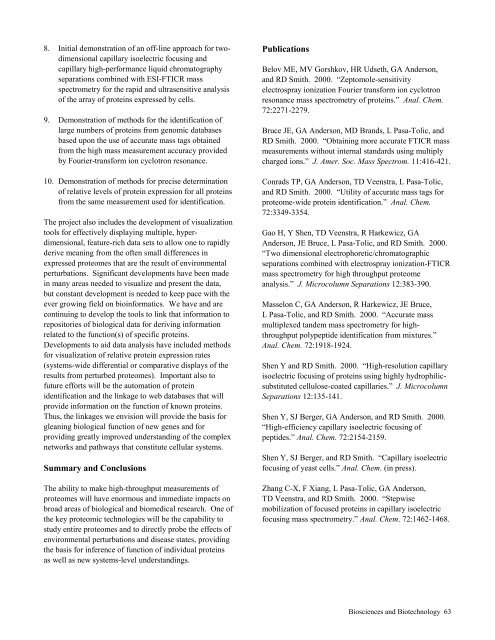PNNL-13501 - Pacific Northwest National Laboratory
PNNL-13501 - Pacific Northwest National Laboratory
PNNL-13501 - Pacific Northwest National Laboratory
Create successful ePaper yourself
Turn your PDF publications into a flip-book with our unique Google optimized e-Paper software.
8. Initial demonstration of an off-line approach for twodimensional<br />
capillary isoelectric focusing and<br />
capillary high-performance liquid chromatography<br />
separations combined with ESI-FTICR mass<br />
spectrometry for the rapid and ultrasensitive analysis<br />
of the array of proteins expressed by cells.<br />
9. Demonstration of methods for the identification of<br />
large numbers of proteins from genomic databases<br />
based upon the use of accurate mass tags obtained<br />
from the high mass measurement accuracy provided<br />
by Fourier-transform ion cyclotron resonance.<br />
10. Demonstration of methods for precise determination<br />
of relative levels of protein expression for all proteins<br />
from the same measurement used for identification.<br />
The project also includes the development of visualization<br />
tools for effectively displaying multiple, hyperdimensional,<br />
feature-rich data sets to allow one to rapidly<br />
derive meaning from the often small differences in<br />
expressed proteomes that are the result of environmental<br />
perturbations. Significant developments have been made<br />
in many areas needed to visualize and present the data,<br />
but constant development is needed to keep pace with the<br />
ever growing field on bioinformatics. We have and are<br />
continuing to develop the tools to link that information to<br />
repositories of biological data for deriving information<br />
related to the function(s) of specific proteins.<br />
Developments to aid data analysis have included methods<br />
for visualization of relative protein expression rates<br />
(systems-wide differential or comparative displays of the<br />
results from perturbed proteomes). Important also to<br />
future efforts will be the automation of protein<br />
identification and the linkage to web databases that will<br />
provide information on the function of known proteins.<br />
Thus, the linkages we envision will provide the basis for<br />
gleaning biological function of new genes and for<br />
providing greatly improved understanding of the complex<br />
networks and pathways that constitute cellular systems.<br />
Summary and Conclusions<br />
The ability to make high-throughput measurements of<br />
proteomes will have enormous and immediate impacts on<br />
broad areas of biological and biomedical research. One of<br />
the key proteomic technologies will be the capability to<br />
study entire proteomes and to directly probe the effects of<br />
environmental perturbations and disease states, providing<br />
the basis for inference of function of individual proteins<br />
as well as new systems-level understandings.<br />
Publications<br />
Belov ME, MV Gorshkov, HR Udseth, GA Anderson,<br />
and RD Smith. 2000. “Zeptomole-sensitivity<br />
electrospray ionization Fourier transform ion cyclotron<br />
resonance mass spectrometry of proteins.” Anal. Chem.<br />
72:2271-2279.<br />
Bruce JE, GA Anderson, MD Brands, L Pasa-Tolic, and<br />
RD Smith. 2000. “Obtaining more accurate FTICR mass<br />
measurements without internal standards using multiply<br />
charged ions.” J. Amer. Soc. Mass Spectrom. 11:416-421.<br />
Conrads TP, GA Anderson, TD Veenstra, L Pasa-Tolic,<br />
and RD Smith. 2000. “Utility of accurate mass tags for<br />
proteome-wide protein identification.” Anal. Chem.<br />
72:3349-3354.<br />
Gao H, Y Shen, TD Veenstra, R Harkewicz, GA<br />
Anderson, JE Bruce, L Pasa-Tolic, and RD Smith. 2000.<br />
“Two dimensional electrophoretic/chromatographic<br />
separations combined with electrospray ionization-FTICR<br />
mass spectrometry for high throughput proteome<br />
analysis.” J. Microcolumn Separations 12:383-390.<br />
Masselon C, GA Anderson, R Harkewicz, JE Bruce,<br />
L Pasa-Tolic, and RD Smith. 2000. “Accurate mass<br />
multiplexed tandem mass spectrometry for highthroughput<br />
polypeptide identification from mixtures.”<br />
Anal. Chem. 72:1918-1924.<br />
Shen Y and RD Smith. 2000. “High-resolution capillary<br />
isoelectric focusing of proteins using highly hydrophilicsubstituted<br />
cellulose-coated capillaries.” J. Microcolumn<br />
Separations 12:135-141.<br />
Shen Y, SJ Berger, GA Anderson, and RD Smith. 2000.<br />
“High-efficiency capillary isoelectric focusing of<br />
peptides.” Anal. Chem. 72:2154-2159.<br />
Shen Y, SJ Berger, and RD Smith. “Capillary isoelectric<br />
focusing of yeast cells.” Anal. Chem. (in press).<br />
Zhang C-X, F Xiang, L Pasa-Tolic, GA Anderson,<br />
TD Veenstra, and RD Smith. 2000. “Stepwise<br />
mobilization of focused proteins in capillary isoelectric<br />
focusing mass spectrometry.” Anal. Chem. 72:1462-1468.<br />
Biosciences and Biotechnology 63

















